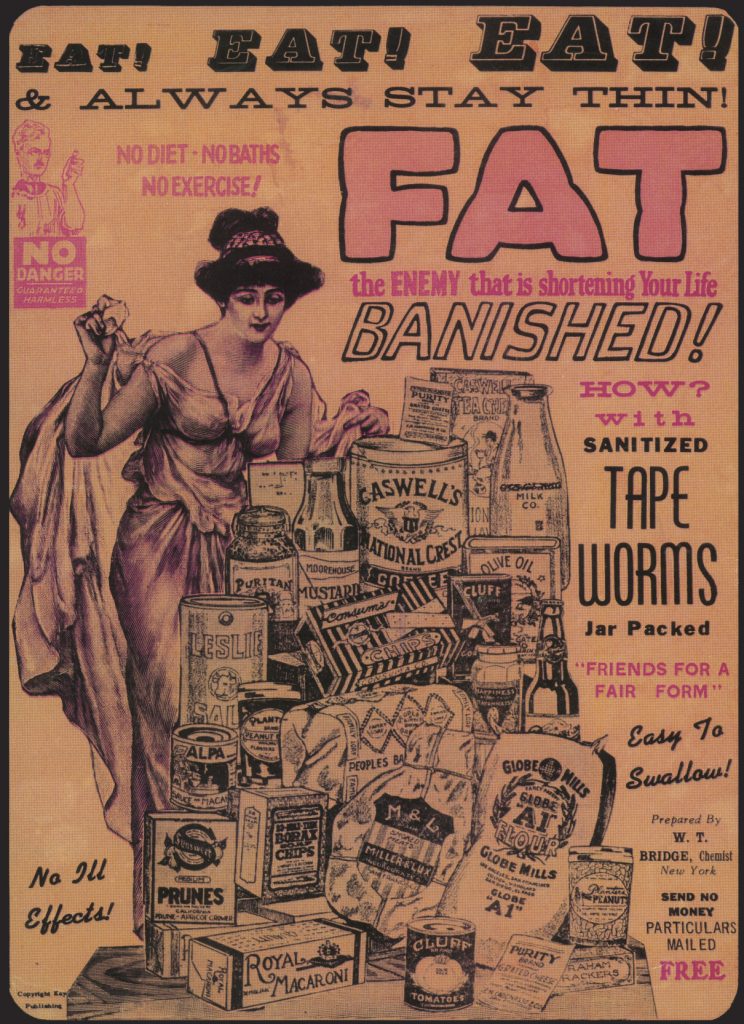Daily History Picture: Tape Worm Advert February 21, 2018
Author: Beach Combing | in : Historical Pictures , trackbackThis seems is supposedly a genuine advert but one that was a joke?!? Love ‘no danger’!
Leif writes in, 28 Feb 2018: We’re going to cry ‘fake’ to a third image reproduced on your site. The advert is certainly humorous, but created after 1949 in a retro style.
Any chance that the advert is serious is easily debunked: ‘Tapeworm pills for fat people merely a wild yarn, say experts.’ Washington Post, 6 December 1912, p. 5. This article quotes then Surgeon General Rupert Blue.
The image appears on Wikipedia commons [https://commons.wikimedia.org/wiki/File:Weight-Loss_Ad_(FDA_154)_(8212182572).jpg] where the author is listed as ‘The U.S. Food and Drug Administration’. This image is 5400 x 6400 resolution (very high) and used in our analysis. It is a montage created from five different images– The ‘Eat! Eat! Eat!’ headline, the ‘Fat the enemy that is shortening your life banished’ headline, the etching of the woman, and the drawing of the food packaging, and the ‘no danger’ man.
We argue the advert is relatively recent based on the following:
(1) The ‘Eat! Eat! Eat!’ headline is a slab serif, italic, outlined, drop shadow typeface with severe drop shadows. It looks like one of the ITC typefaces that were quite popular in the 1970s. Ink bleeds into the white letter outlines in the ‘Eat! Eat! Eat!’ headline, a flaw consistent with phototype (invented1949). Scratches also appear in the ‘Eat! Eat! Eat!’ type, demonstrating it was created from a film negative and printed using offset lithography.
(2) Caroline Rance at theQuackDoctor.com identifies the source for the ‘Fat the enemy that is shortening your life banished’ headline: an advert for Neutroids, a weight-loss supplement, printed in ‘Screenland’ magazine in 1923. The hand drawn type in the Neutroids displays higher quality draftsmanship, indicating the tapeworm advert is a copy, not the original
(3) The illustration of the woman is quite sharp, with no bleeding. The line work indicates it was an engraving and printed using letterpress. There are also cut lines visible around the woman, indicating the image was sampled. She is dressed in a classical revival style consistent with fashion of 1890-1910. This date is consistent with the method of reproduction.
(4) The ‘no danger’ man is sampled from a pen and ink drawing.
Conclusions: The advert combines images produced in different eras using different media and technologies. The ‘Eat! Eat! Eat!’ headline comes from an original created after 1949. In addition:
(5) The copyright notice in the lower left corner of the image is partly obscured.
(6) The advert states ‘Send no money, particulars mailed free’, yet fails to include an address.
(7) The image appears on Wikipedia commons [https://commons.wikimedia.org/wiki/File:Weight-Loss_Ad_(FDA_154)_(8212182572).jpg] where the author is listed as ‘The U.S. Food and Drug Administration’. The page contains a link to the FDA website, which in turn links to the FDA’s Flick.com photostream. The tapeworm diet advert doesn’t appear in their collection, and we have not been able to find any reference to it in the FDA site.
We strongly suspect the advert was produced using electronic publishing technology, which made montages like this much easier to create. Today it would be easy to create the ‘Eat! Eat! Eat!’ headline using public domain fonts. The fact that it was sampled from a phototype source argues the advert was created in the early days of electronic publishing, possibly 1985-1995.



